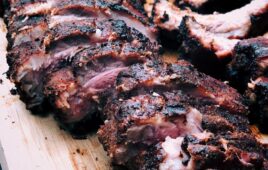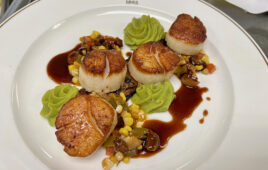Club chefs are taking upscale ingredients and serving them in modern yet approachable ways.

Casual club dining has evolved—and rightfully so. Club chefs with fine-dining pedigrees are pushing the movement in a new direction. They’re introducing upscale ingredients into everyday dishes like burgers, meatloaf, pizza and pasta. They’re serving these culinary mash-ups to members wearing jeans who are sitting by the pool, at the bar or at a communal table.
Against this new casual club-dining backdrop, chefs are engaging members in an exciting culinary adventure, where quality and flavor come first.
Playing with Presentation
Ryan Daniels, Executive Chef of Fiddlesticks Country Club (FCC) in Fort Myers, Fla., creates chef-driven menus for FCC’s upscale and casual outlets. The difference between the two, he says, isn’t in the quality of what’s being served; it’s in how the final dish is presented to the member (see photos, above).

Fiddlestick CC’s Executive Chef, Ryan Daniels, says it’s important to know how adventurous members are, and to be careful with dishes that are especially nostalgic.
“I’m fortunate to have a team of people who really love to cook,” says Daniels. “Together, we brainstorm ideas for dishes and find ways to take traditionally upscale ingredients and incorporate them in a way that will enhance the dish.”
For example, Daniels does sliders in the pub, but substitutes beef for lamb and serves the patty between two rounds of grilled pita. He tops the slider with a crunchy cucumber-fennel salad, tzatziki, and feta cheese.
Instead of a traditional beef tartare, Daniels uses a venison loin. “In the marinade, we incorporate flavors that marry well with venison, like juniper, allspice and orange,” he says. The final dish is paired with a roasted garlic crema.
FCC’s striped bass is plated on a bed of brown rice, pickled cucumber, Kennett Square shiitake and a soy reduction. Ramen features a house-cured and sous-vide’d pork belly, scallions from the club’s garden, a soft-cooked egg and a bacon-dashi broth.
“There is a fine line between putting a modern twist on a classic dish and taking it too far,” says Daniels, who changes menus weekly. “It’s important to know how adventurous your members are, and to be careful with dishes that are especially nostalgic.”
Daniels’ pierogi offer a perfect example. “Everyone I know grew up eating potato-and-cheese pierogi,” he says. “We make ours from a scratch pierogi dough recipe that was my grandmother’s. We fill the dough with short ribs, earthy aromatics, brunois vegetables and aged cheddar cheese. And we pair the finished pierogi with a dill chimichurri and carrot puree.”
The final result is a deeply satisfying, casual, comfort dish.
Because Daniels sources high-quality ingredients, he strives to make the most of each. With his beet risotto, for example, he uses the tops to create a bright green vichyssoise.
“The little details are what make casual dining successful,” he continues. “You’re never going to get everyone on board with every dish you serve. But the more you understand what your members like, the more progressive you can be.”
Gaining Trust
At Salem Golf Club in North Salem, N.Y., farm-to-table is the focus of the club’s $1.6 million dining program, which skews casual. “Our members don’t want to get dressed up to use their club,” says Chad Esposto, Executive Chef. “But casual doesn’t mean lazy.”

“Our members don’t want to get dressed up to use their club. But casual doesn’t mean lazy.”
—Chad Esposto (above), Executive Chef, Salem GC
Quite the opposite. In fact, Esposto, like Daniels, changes the club’s menus weekly so he can capitalize on whatever his farmers have available. “We’re inspired by these really high-quality, fresh ingredients,” he says.
While he does incorporate upscale ingredients in subtle ways—as with Atlantic halibut with truffled mushroom risotto, or his bronzini Provençal—Esposto struggles with getting members to take the leap of faith and try new things.
The best way around this, he explains, is to do progressive dinners on the course and feature small plates of any new concepts during these events.
“We use that time as an opportunity to introduce members to new ideas and dishes,” says Esposto.
‘Wow’ Factor
At The Country Club at Castle Pines (Castle Rock, Colo.), Executive Chef Joe Martin likes to deconstruct traditional comfort foods and find ways to reinvent them for the club’s 600 members.
Take, for example, the Castle Pine Burger. Designed for hungry golfers as they come off the course, the burger is built with a “La Freida” patty. It’s topped with applewood smoked bacon, fried poblano peppers, fried onions, cheddar cheese, sliced avocado, housemade BBQ sauce and a sweet corn aioli.
“The only thing I want my members to say when we set that burger down in front of them is ‘How do I put this in my mouth?’” says Martin. “We want our dishes to have a ‘wow’ factor, especially casual picks, and the Castle Pines Burger doesn’t disappoint.”
Martin’s goal is not necessarily to take a classic dish and totally transform it into something unrecognizable. Rather, he seeks to improve the process and the dish in any way, big or small.
For Thanksgiving, for example, he broke down the turkeys, brined the breast and sous vide’d it at 150° for three hours. Then he roasted the breasts until they came up to temp and had a beautiful color. For the legs, he cured them like duck confit.
“I am always looking to improve the process behind a dish,” says Martin, who also seeks to inspire his staff to be equally creative and sharp.




